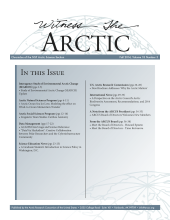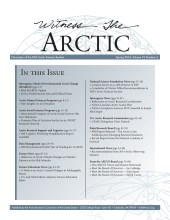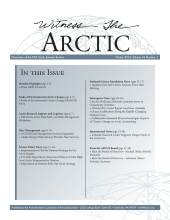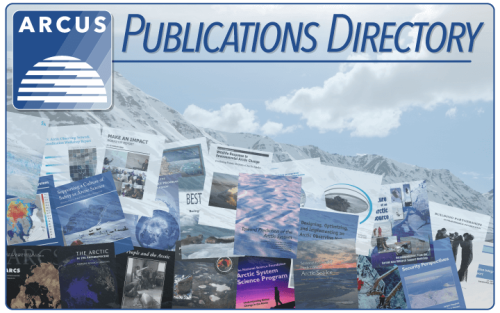
The ARCUS Publication Directory is a portal that includes science planning documents, white papers, newsletters, and other reports that are outside of the peer review literature.
The publications index is listed in chronological order beginning with the most recent publication.
Displaying 201 - 210 of 262 publications.
Sea Ice Outlook: 2014 Post-Season Report
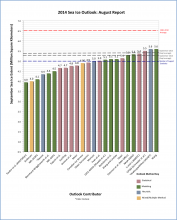
The 2014 Sea Ice Outlook (SIO) Post-Season Report was developed by the SIO Action Team, led by Julienne Stroeve, with input from the Sea Ice Prediction Network (SIPN) Leadership Team and with feedback following circulation of the draft report to the SIPN mailing list.
INTRODUCTION
We appreciate the contributions by all participants and reviewers in 2014. The SIPN Sea Ice Outlook (SIO), a contribution to the Study of Environmental Arctic Change (SEARCH), provides
Increasing Arctic Accessibility Over the Next Twenty Years

James Morison, Jacqueline Richter-Menge, Kristina Creek, Peter Griffith, Steve Oberbauer, Sophia Perdikaris, Matthew Shupe, Craig Tweedie, Helen Wiggins (eds.), Increasing Arctic Accessibility Over the Next Twenty Years: Arctic Research Support and Logistics Workshop Report. Arctic Research Consortium of the US (ARCUS), Fairbanks, Alaska. 2014. 56 pp.
Designing, Optimizing, and Implementing an Arctic Observing Network
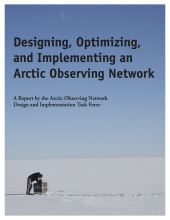
AON Design and Implementation Task Force. Designing, Optimizing, and Implementing an Arctic Observing Network (AON): A Report by the AON Design and Implementation Task Force. Study of Environmental Arctic Change (SEARCH), Fairbanks, Alaska. 2012. 64 pp.
Sea Ice Outlook: 2014 August Report
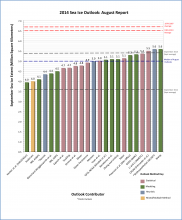
OVERVIEW
Thank you to the groups that contributed to the August 2014 Outlook. We received 23 pan-Arctic contributions. Of the 23 contributions, some are unchanged from July. The median Outlook value for September extent is 5.0 million square kilometers with a quartile range from 4.58 to 5.22 million square kilometers. The overall range is between 4.0 and 5.6 million square kilometers. The median value for August is increased from the June and July values of 4.7 and 4.8 million square kilometers, respectively. This increase reflects the relatively slower decline in ice extent through August
Sea Ice Outlook: 2014 July Report
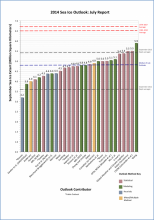
EXECUTIVE SUMMARY
Thank you to the groups that contributed to the July 2014 Sea Ice Outlook; we received 28 pan-Arctic contributions and always appreciate the diversity of contributions.
The July Outlook report was developed by Walt Meier, NASA Goddard Space Flight Center, and the rest of the SIPN leadership team, with a section analyzing the model contributions by François Massonnet, Université Catholique de Louvain.
The median Outlook value for September 2014 sea ice extent is 4.8 million square kilometers with quartiles of 4.4 and 5.0 million square kilometers. Thus, the median
Sea Ice Outlook: 2014 June Report
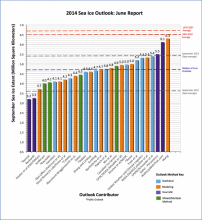
Full Outlook Report
Overview
Thank you to the groups that contributed to the 2014 season, 28 pan-Arctic contributions (plus one additional regional) is a record for the Sea Ice Outlook (SIO)! We appreciate the diversity of contributions. The median Outlook value for September 2014 sea ice extent is 4.7 million square kilometers with quartiles of 4.2 and 5.1 million square kilometers (See Figure 1). Thus we have a large distribution of Outlooks, which is not surprising given the different observed values from 2012 and 2013. The overall range is also large at 3.2 to 6.3 million
Thank you to the groups that contributed to the 2014 June report; 28 pan-Arctic contributions (plus one additional regional) is a record for the Sea Ice Outlook! We also welcome several new groups this year.
This June Outlook report was developed by lead authors, Walt Meier (NASA) and Jim Overland (NOAA), with contributions from the rest of the SIPN leadership team, and with a new section this year analyzing the model contributions by François Massonnet, Université Catholique de Louvain.
Sea Ice Outlook: 2013 Post-Season Report
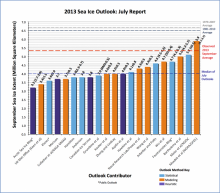
POST-SEASON REPORT
HIGHLIGHTS & TAKE-HOME POINTS
Loss of summer Arctic sea ice took a pause in 2013 with September 2013 having the 6th lowest extent since satellite observations began in 1979: 5.4 million square kilometers, based on National Snow and Ice Data Center (NSIDC) estimates. The seven lowest minimum ice extents have occurred in the last seven years, 2007-2013.

